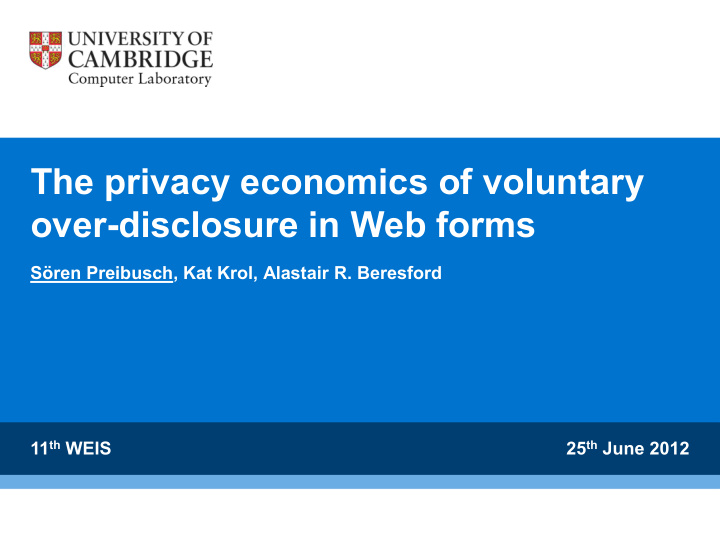



The privacy economics of voluntary over-disclosure in Web forms Sören Preibusch, Kat Krol, Alastair R. Beresford 11 th WEIS 25 th June 2012
Web forms: ubiquitous, versatile, est. 1995 Primary mechanism for explicit data collection Considered a nuisance (time, effort, distraction) Inconclusive user experience advice Technical easing of form-filling Sören Preibusch 2
Online questionnaires vs. transactional Web forms Sören Preibusch 3
Object of assessment and methodology Users’ behaviour when providing optional personal information on a Web form Field experiment on mTurk: 1500 participants (US) Web form with 10 optional + 2 check questions No input checks; participants always paid Sören Preibusch 4
Apparatus, treatments, sample size compensation data req. $ .25 $ .50 low 202 216 chk high 209 445 chk, col, sun bonus 181 chk, [col, sun] Sören Preibusch 5
Revelation ratios by data item and treatment Date of birth disclosed least often: 57% (partial DOB: 68%) Weather, favourite colour disclosed most: 87% Most recent browser used: 66% Browser correctly named: 96% Sören Preibusch 6
Significant prevalence of voluntary over-disclosure Mandatory / optional response drop (p < 0.0001) Wide-spread voluntary over-disclosure (p < 0.0001) ‗ All vs. none optional fields: 10× as often Significantly over-detailed responses ‗ 6% give weather details “No. It's currently cloudy and rainy” ‗ 14% give purpose of spending (on top of date) “4 days ago getting groceries” Sören Preibusch 7
Over-disclosure by accident – but not only! O/D more prevalent when instructions not read ‗ Date of birth: 67% vs. 87%, p < 0.0001 ‗ Good person: 81% vs. 90%, p = 0.0001 ‗ 93% recalled that questions optional Retrospectively personal information ‗ Personal data: 62% ‗ Personal and sensitive: 8% (who disclosed DOB, p < 0.05) Privacy costs of over-disclosure Sören Preibusch 8
Non-privacy costs of over-disclosure 120 1000 absolute frequency 90 100 seconds 60 10 30 0 1 0 1 2 3 4 5 6 7 8 9 10 number of fields completed participant count seconds spent until submission Sören Preibusch 9
Chilling effects of mandating fields Weather and favourite colour (least sensitive fields) made mandatory: disclosing behaviour reduced ‗ for remaining medium sensitivity good person (p < 0.04) ‗ for remaining high sensitivity date of birth (p < 0.02) Even if mandatory items were provided anyway ‗ average 1.3 fields less provided (p < 0.0001) ‗ date of birth (p < 0.0001) Sören Preibusch 10
Higher base reward may increase disclosure ratio Comparing treatments with high vs. low reward Effect of higher rewards by data item sensitivity: ‗ Low sensitivity: weather , fav. colour (p = 0.001) ‗ Medium sensitivity: good person (p = 0.003) ‗ High sensitivity: date of birth: no effect (not significant) No moderating effect of reciprocal personality Sören Preibusch 11
Crowding-in of incentivised disclosure Extra $ .25 for disclosing weather and fav. colour Highly effective for increasing disclosure (p < 0.0001; as effective as mandatoriness) Spillover to non-incentivised data items ‗ good person (p = 0.002) ‗ date of birth (p < 0.001) Sören Preibusch 12
Motivation to participate For the money: 54% Interesting: 25% Looked easy: 30% Articulate opinions: 3% ‗ “my information goes Joy: 15% towards creating a change in something” ‗ “It looked interesting, fun ‗ “the opportunity to present and easy to do” an underrepresented demographic (conserva- Help research: 8% tives, mothers) in surveys” ‗ “Any help I can be for research, I am glad to do” Sören Preibusch 13
Plausible motives for voluntary over-disclosure By accident Speculating on return ‗ Social capital build-up Limit disclosure ‗ Monetary bonus too costly ‗ Non-monetary returns (e.g., personalisation) Personality ‗ Infrastructure ‗ Reciprocity improvements ‗ Benevolence ‗ Opinion shaping ‗ Extroversion ‗ Completionist Sören Preibusch 14
Take-home messages Web users incur costs from highly prevalent, voluntary over-disclosure: time, effort, privacy loss. Incentives create positive spillover towards higher disclosure. Mandating some fields reduces voluntary disclosure for the remaining. Sören Preibusch 15
Recommend
More recommend